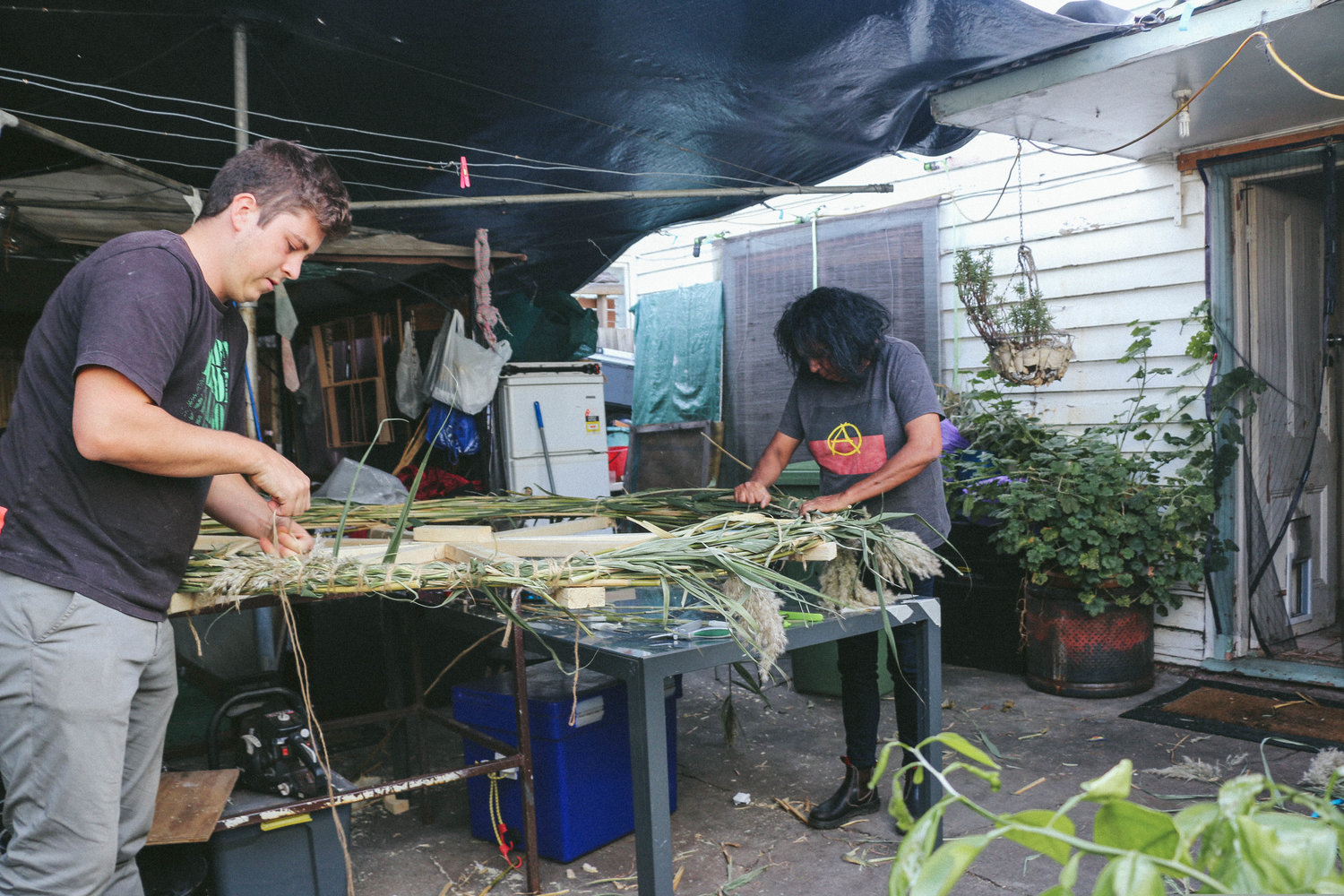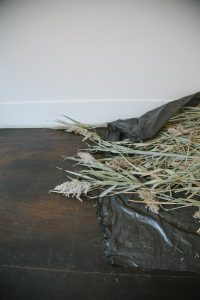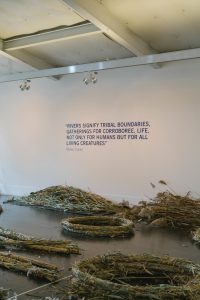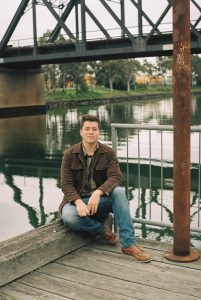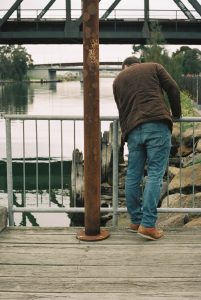Boon Wurrung artist, Mitch Mahoney and Mutti Mutti and Boon Wurrung/Wemba Wemba artist Maree Clarke are creating a 10-metre-long eel trap out of river reeds in Footscray. We spoke to Mitch Mahoney about the role ancient wisdom will play in a more sustainable future and how we, like eels, can adapt to changing environments.
Mathew Bate: For starters, why don’t you introduce yourself and tell us where you’re from and where we are right now?
Mitch Mahoney: Well, my name’s Mitch Mahoney. I’m a young Boon Wurrung artist and I grew up in Mildura along the Murray river. I spent maybe six or seven years of my life there, then maybe 13 years up in New South Wales in the Hunter Valley. I’m currently down in Melbourne and I’ve been here for about a year but I’ve also had a lot of family connections here in Melbourne through my Aunty Maree Clarke and a lot of other cousins, uncles and different family members.
Right now we’re at the Footscray Community Arts Centre working on a project that we’re doing with DISPOSABLE, making a 10-metre-long eel trap out of river reeds. We’re trying to address subjects like sustainable living, Aboriginal technology and what non-Indigenous people and Australia as a whole can learn from 60,000 years of Aboriginal people managing our land and our waterways.
Can you tell me about farming eels and the ancient wisdom passed down through the eel trap?
For me in this exhibition, we’re using the eel trap as an ephemeral artwork because it represents the farming of eels and the farming of fish. The farming of eels is something we’ve been doing for thousands of years, [which involves] building artificial waterways that come off river systems and are set up in dams and streams that interconnect. Along those streams and along those dam systems, we’d have eel traps set up to catch the larger of the eels, allowing the smaller ones to continue on to the next generation.
Once the eels are caught they are then smoked, which preserves them so they can be used as a source of food and as a trading good. But as well as that, because we smoked our eels and we had them preserved, it meant that we had a surplus of food. This is something that is very contradictory to the stereotypical view of Indigenous living, which is, you know, people who move all across the country in a nomadic sense, not ever really building up stores of food or building permanent structures. Indigenous people actually did have more long-term living areas and eel traps and eel farms are a very prominent sign that we had more permanent, structural living areas.
This piece seems to be quite metaphorical. Does the eel trap also represent the need to reconcile non-Indigenous and Indigenous wisdom so we can move forward together?
Hmm, that’s a hard question. In a way, yes, it is a bit of a reconciliation piece, but at the same time it’s more focusing on the idea of getting non-Indigenous people interested in Indigenous culture, in terms of our aquaculture and our agriculture. Getting them to look at things like the eel trap, things like the fishing that we’ve done, things like our kangaroo grass, our murnong yam and native bush tuckers. We’re looking at the way that we’ve spent 60,000 years sustainably looking after this country in a very proactive way, working with the country rather than against it. We’ve naturally been, you know, an animal within our own ecosystem. Playing our part in that ecosystem in terms of burning off, pulling out species of plants that were strangling others and growing certain plants that were either used for making tools, being eaten or for other animals to eat so that everything could continue.
Generally, the attitude was that if a plant had no place in an environment, it’d be pulled out and it would actually be discarded. So if it wasn’t for animals to eat, for making tools or for personal consumption – or if it didn’t have some spot in that environment – then generally it would be pulled out or managed. So what I’m trying to do is get people to look at that; get people to look at a different kind of attitude towards working with our environment. And as well as that, get people to focus on the point that we’re doing it so wrong these days.
The best example is – and the new stats are pretty sobering – that fishing nets alone make up 60 percent of our ocean’s plastic. Think about everything else that must be in the ocean. If there’s that many leftover fishing nets out there, imagine how many nets are out there catching tonnes and tonnes of fish and only taking the fish they want, throwing the rest out as bycatch that always end up dead and thrown out like deadweight. I want us to look at that in contrast to how Indigenous people treat animals and how we look at our country. What can we do to change what we’re doing now to be more aligned with Indigenous law, in terms of land management and water management?
This art piece is a collaboration, or a mentorship, between you and your Aunty, the artist Maree Clarke. Can you tell me about how that process started and what it’s been like?
This piece is a collaboration between me and my Aunty Maree Clarke. It’s a long story, how that all started. My art career really started with the making of possum skin cloaks, which is something that I was taught [by] Aunty Maree Clarke, Aunty Vicki Cousins and Aunty Lee Darroch.
Possum skin cloaks?
Yeah, so for us, possum skin cloaks are a very personal item. They have a huge cultural significance and are very sacred. They tell our stories, they tell who we are and they’re an item that we keep for the duration of our life, from when we’re born to the moment we die. I made my first possum skin cloak when I was 16 with the help of Aunty Maree Clarke. Ever since, I’ve been doing different things like totem poles, a lot of possum skin work and I started doing different drawings and things like that. And then when I moved to Melbourne, Aunty Maree wanted me to come on board to help her with projects. Now we’ve come to Footscray and we’re doing a project together, a collaboration, making a big 10-metre-long eel trap made out of river reeds that we’re going to float down on the Maribyrnong River, which is quite amazing.
As we chat right now there are people inside helping to build the eel trap in a workshop. But it kind of started in April or May when you were building some of the frames with Aunty Maree Clarke.
Yeah, so it’s been a long project. It hasn’t officially been happening the whole time, but we did start quite early. We started before the winter came because of the river reeds. You want to collect them green and so we need to collect them in the late autumn, just before winter comes along while they’re still nice and green and bendy. We spent weeks bending them into big circles to make up the rings that eel traps are made up of, then collecting more and more for storage to make the crossbars, which will hold the eel trap together. So it’s been quite a long journey and it’s been quite an extensive project, even up until today, where we’ve been open for a week and we’ve got another two and a half weeks to go.
What is it like, having the opportunity to learn from Aunty Maree Clarke and then also passing that knowledge down to the volunteers and the people that come into your workshops? Is that an important part of the piece as well, that passing on of knowledge?
For me, that’s one of the most important parts. I’ve learnt about eel traps, about about making large things, about how to manage projects like this and how to run them. But yeah, it’s really important to be able to get people in, get them involved, get them to do a bit of work on the piece themselves so that they can feel like they’ve been a part of it. And then getting them having those conversations about sustainability and highlighting what Indigenous people do.
I’m also here so non-Indigenous people can see that Aboriginal people are out here doing this work, making these things. We’re getting them interested so hopefully they can continue to learn about the good things in our culture, in terms of our respect for the land and the way that we treat our environment.
The ways that eels operate in the landscape, going from freshwater to saltwater, sort of represents crossing boundaries. The eel itself seems to be a symbol of what you’re talking about, going from one environment or culture to another. I was reading that apparently when eels migrate their eyes get bigger before they cross over from freshwater to saltwater. I loved learning about this because when we try to understand cross-cultural narratives and ancient knowledge we also have to open up our eyes.
It’s exactly that. The eel for us is a sacred thing, especially down here in the Kulin nation. It’s a huge source of food. Down here we’ve got five different clans within the Kulin nation, the Boon Wurrung being my people. For us as Boon Wurrung people, the eels are one of the largest migrations in the world of short-finned yellow-belly eels up the Yarra river, which is the Birrarung, every single year. They come all the way from the Coral Sea to spawn, so it’s a long journey. They come up and they lay their eggs just like the salmon in America up in the freshwater, and then as they get up there the babies will come down to swim back to the Coral Sea with their ancestral memory telling them where to go.
This links into so many things like ancestral memory, which seems to be something that is built into your DNA, knowing about your culture having that connection to your country, having that connection to family and to your people. It represents that as well as representing the crossing of the boundary between freshwater and saltwater, which is a crossing of boundaries from our small view of the world into the larger view.
This means accepting Indigenous perspectives of our landscape and working together, putting aside our differences and trying to figure out what would be best for this country as a whole. It’s posing the question: what part will Indigenous people have in our future, in fixing the problems we have since we’ve been here the longest and we have known how to manage the land for the longest? I think we should have a very key role in finding solutions, especially our young people coming up today.
So you’ll be launching this massive eel trap into the Maribyrnong River, which will be happening on the 23rd of August, and there’s probably a higher chance of catching plastic than eels.
Oh, definitely!
So in the current context of a climate crisis, and you touched on ocean waste, what can we learn from the ancient practise of eel farming and how your ancestors managed the land?
I think the number one thing to learn is that we need to be ready to adapt. We need to be ready to change our minds and change our perspectives on things and we need to be ready to accept things that don’t flow with what the current norm is. I think, yeah, be ready for change. It’s one of the things that actually relates to the eel a lot: they’re able to live in fresh water and salt water, they can go out of the water and go overland. What are we willing to sacrifice to help fix the future and how much are we willing to adapt for it?
Eel Trap by Mitch Mahoney and Maree Clarke is showing from 31 July until 31 August at the Footscray Community Arts Centre and is part of the DISPOSABLE exhibition for Science Gallery Melbourne. The eel trap will be launched into the Maribyrnong river on 23 August, from 6pm. More details HERE.

